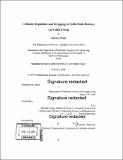Lithium deposition and stripping in solid-state battery via coble creep
Author(s)
Wang, Ziqiang,Ph. D.Massachusetts Institute of Technology.
Download1196094760-MIT.pdf (13.51Mb)
Other Contributors
Massachusetts Institute of Technology. Department of Materials Science and Engineering.
Advisor
Ju Li.
Terms of use
Metadata
Show full item recordAbstract
Solid-state Li metal batteries require accommodation of electrochemically generated mechanical pressure inside Li metal. In this thesis it shows, through in situ transmission electron microscopy experiment of Li and Na deposition/stripping in mixed ionic-electronic conductor (MIEC) hollow tubules, an intriguing result that (a) Li metal can flow and retract inside 3D MIEC channels as a single crystal, (b) Coble creep dominates via interfacial diffusion along the MIEC/metal phase boundary, (c) this MIEC electrochemical tubular matrix can effectively relieve stress, maintain electronic and ionic contact, eliminate solid-electrolyte interphase (SEI) debris, reduce the possibility of "dead lithium", and allow the reversible deposition/stripping of Li metal across a distance of many microns, for 100 cycles. This thesis proposes quantitative design rules for MIEC electrochemical cell and shows that interfacial diffusion greatly liberates MIEC material choices when using ~100 nm wide and 10-100[mu]m deep channels. A centimeter-scale, ~10¹⁰ MIEC cylinders/solid electrolyte/LiFePO₄ full cell shows high capacity of ~ 164 mAh/g(LiFePO₄ and almost no degradation for over 50 cycles, starting with 1x excess Li.
Description
Thesis: Ph. D., Massachusetts Institute of Technology, Department of Materials Science and Engineering, 2020 Cataloged from the PDF of thesis. Includes bibliographical references (pages 104-107).
Date issued
2020Department
Massachusetts Institute of Technology. Department of Materials Science and EngineeringPublisher
Massachusetts Institute of Technology
Keywords
Materials Science and Engineering.